State microbe
A state microbe is a microorganism used as an official state symbol. Several U.S. states have honored their microbial residents by nominating them to become official state symbols. The first state to declare an Official State Microbe is Oregon which chose Saccharomyces cerevisiae (brewer's or baker's yeast) as the Official Microbe of the State of Oregon in 2013 for its significance to the craft beer industry in Oregon.[1] One of the first proponents of State Microbes was the eminent microbiologist Dr Moselio Schaechter, who, in 2010, commented on Official Microbes for the American Society for Microbiology's blog "Small Things Considered" [2] as well as on National Public Radio's "All Things Considered". [3][4]
Wisconsin 2009: Lactococcus lactis, proposed, not passed
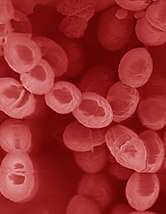
In November 2009, Assembly Bill 556 that proposed designating Lactococcus lactis as Wisconsin state microbe was introduced by Representatives Hebl, Vruwink, Williams, Pasch, Danou, and Fields; it was cosponsored by Senator Taylor.[5] Although the bill passed the Assembly 56 to 41, It was not acted on by the Senate.[6] The proposed AB 556 simply stated that Lactococcus lactis is the State Microbe and should be included in the Wisconsin Blue Book,[7] an almanac containing information on the state of Wisconsin, published by Wisconsin’s Legislative Reference Bureau.[8]
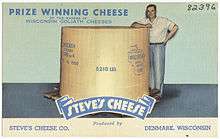
Lactococcus lactis was proposed as the State Microbe because of its crucial contribution to the cheese industry in Wisconsin. Wisconsin is the largest cheese producer in the United States, producing 3.1 billion pounds of cheese, 26% of all cheese in the US, in more than 600 varieties (2017 data).[9]
Lactococcus lactis is vital for manufacturing cheeses such as Cheddar, Colby, cottage cheese, cream cheese, Camembert, Roquefort, and Brie, as well as other dairy products like cultured butter, buttermilk, sour cream, and kefir. It may also be used for vegetable fermentations such as cucumber pickles and sauerkraut.[10]
Hawaiʻi 2013-14: Flavobacterium akiainvivens and/or Aliivibrio fischeri, to be continued ...

In January 2013, House Bill 293 was introduced by State Representative James Tokioka; the proposed bill designates Flavobacterium akiainvivens as the State Microbe of Hawaiʻi.[11] The bacterium was discovered on a decaying ʻākia shrub by Iris Kuo, a high school student working with Stuart Donachie at the University of Hawaiʻi at Manoa.[12][13] The Hawaiʻian context is strong here because the ʻākia shrub (Wikstroemia oahuensis) is native to Hawaiʻi, and the microbe (Flavobacterium akiainvivens) was first found in Hawaiʻi. The shrub was used by ancient Hawaiʻians for medicine, textiles and for catching fish, while the microbe may have antibiotic properties.[11]
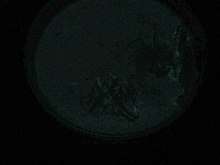
Although it was favored by the House, the Flavobacterium akiainvivens bill failed to get a hearing in the Senate Technology and Arts Committee (TEC) and could not move forward for a Senate vote.[14]
.jpg)
In February 2014, Senate Bill 3124 was introduced by Senator Glenn Wakai; the bill designates Aliivibrio fischeri as the State Microbe of Hawaiʻi.[15] [16] Senator Wakai was Chairman of the Senate Technology and Arts Committee that squashed the Flavobacterium legislation. Aliivibrio fischeri was selected because it lives in a symbiotic relationship with the native Hawaiʻian bobtail squid, in which it confers bioluminescence on the squid, enabling it to hunt at night.[16] Although this is an awesome example of symbiosis, political and scientific controversy erupted because even though the bobtail squid is only found in Hawaiʻi, Aliivibrio fischeri can be found elsewhere.[17][18]
The combined Hawaiʻian Legislature could not agree on which microbe better suited Hawaiʻi, and the proposed legislation was dropped. [19]
Legislation proposing Flavobacterium akiainvivens as the State Microbe was re-introduced in 2017, .
Oregon 2013: Saccharomyces cerevisiae, passed

Oregon was the first state to declare an Official State Microbe.
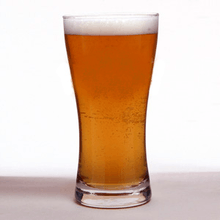
In February 2013, House Concurrent Resolution 12 (HCR-12) was introduced into the Oregon legislative system by Representative Mark Johnson; the bill designates Saccharomyces cerevisiae (brewer's yeast or bakers yeast) as the Official Microbe of the State of Oregon.[20] The bill was passed by unanimous vote in the House on April 11; it passed in the Senate by a vote of 28 to 2 on May 23. [21] Cosponsors of the measure were: Representatives Dembrow, McLane, Vega Pederson, Whisnant, Williamson, and Senators Hansell, Prozanski, and Thomsen.[21]
HCR-12 recognizes the history of Saccharomyces cerevisiae in baking and brewing, thanks to its ability to convert fermentable sugars into ethanol and carbon dioxide. Most important for Oregon is that the microbe is essential to the production of alcoholic beverages such as mead, wine, beer, and distilled spirits. Moreover Saccharomyces cerevisiae inspired the thriving brew culture in Oregon, making Oregon an internationally recognized hub of craft brewing.[22] The craft brewing business brings Oregon $2.4 billion annually, thanks to brewers yeast and talented brewers.[23]
New Jersey 2017-2018: Streptomyces griseus, pending
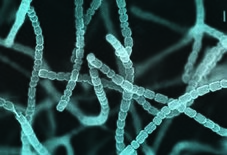
Introduction
Streptomyces griseus was chosen for the honor of becoming the New Jersey State Microbe because the organism is a New Jersey native that made unique contributions to healthcare and scientific research worldwide. A strain of S. griseus that produced the antibiotic streptomycin was discovered in New Jersey in “heavily manured field soil” from the New Jersey Agricultural Experimental Station by Albert Schatz in 1943.[24] Streptomycin is noteworthy because it is: the first significant antibiotic discovered after penicillin; the first systemic antibiotic discovered in America; the first antibiotic active against tuberculosis; first-line treatment for plague. Moreover, New Jersey was the home of Selman Waksman, who was awarded the Nobel Prize in Physiology or Medicine for his systematic studies of antibiotic production by S. griseus and other soil microbes.[25]
Legislative Activity
On May 15, 2017, Senate Bill 3190 (S3190) was introduced by Senator Samuel D. Thompson (R-12); the bill designates Streptomyces griseus as the New Jersey State Microbe, to be added to the state's other state symbols. On June 1, 2017 Assemblywoman Annette Quijano (D-20) introduced Assembly Bill 4900 (A4900); the bill also designates S. griseus as the New Jersey State Microbe, and is the Assembly counterpart of S3190.[26] S3190 was referred to the Senate State Government, Wagering, Tourism & Historic Preservation Committee and A4900 was referred to the Assembly State and Local Government Committee for consideration and review.[27]

On December 11, 2017 (the birthday of Dr Robert Koch) S3190, the bill that designates S. griseus as the New Jersey State Microbe, was unanimously approved by the NJ Senate State Government. Wagering, Tourism & Historic Preservation Committee. Committee members were Senators Samuel Thompson (sponsor), James Beach (chair) Shirley Turner (vice chair), and Patrick Diegnan. Speaking on behalf of the State Microbe were Drs John Warhol, Douglas Eveleigh[28], and Max Haggblom[29].
On January 8, 2018 the full New Jersey Senate unanimously approved (38 to 0) S3190 to designate S. griseus as the New Jersey State Microbe.[30] The bill was cosponsored by Senator Fred H. Madden (D-4).[31] The Assembly did not act on its version of the State Microbe legislation.
State Microbe legislation was reintroduced in the New Jersey Senate on February 5, 2018 by Senator Samuel Thompson (R-12); the bill number is S1729.[32] The bill will be reviewed by the NJ Senate State Government, Wagering, Tourism & Historic Preservation Committee whose members are Senators Samuel Thompson, James Beach (chair) Shirley Turner (vice chair), Chris A. Brown, and Nilsa Cruz-Perez. The new senate bill has bipartisan support and is cosponsored by Senator Patrick Diegnan (D-18) and Senator Vin Gopal (D-11).[33]
Similar legislation was reintroduced in the New Jersey Assembly on March 12, 2018; the bill number is A3650. The legislation is sponsored by Assemblywoman Annette Quijano (D-20), ASW Patricia Jones (D-5), Assemblyman Arthur Barclay (D-5), ASM Eric Houghtaling (D-11), and ASW Joann Downey (D-11).[34] Assemblyman Ronald Dancer (R-12) also signed on as a cosponsor.[35] The bill will be reviewed by the Assembly Science, Innovation and Technology Committee, whose members are ASM Andrew Zwicker, PhD (D-16), ASM James Kennedy (D-22), ASM Herb Conaway, MD (D-7), ASW BettyLou DeCroce (R-26), ASM Christopher DePhillips (R-40), ASM Time Eustace, DC (D-38), and ASW Brittnee Timberlake (D-34).[36]
On June 14, 2018 Senate Bill S1729 was unanimously approved by the NJ Senate State Government, Wagering, Tourism & Historic Preservation Committee. [37]
On July 27, 2018 Senate Bill S1729 was unanimously approved (33 to 0) by the full New Jersey Senate. [38] From the well of the Senate, Senator Thompson kindly acknowledged the efforts of State Microbe advocates John Warhol, Douglas Eveleigh, Jeff Boyd, and Jessica Lisa.
On September 17, 2018 Assembly Bill A3650 was unanimously approved by the Assembly Science, Innovation, and Technology Committee.[39] Testifying on behalf of the State Microbe were Drs John Warhol, Douglas Eveleigh, and Jeff Boyd; their testimony can be heard on the New Jersey Legislature Media site [40] starting at 27 minutes. Asm Tim Eustace on The Committee was replaced by Assemblywoman Linda S Carter.
Education Activity
The Rutgers University School of Environmental and Biological Science (SEBS) Department of Biochemistry and Microbiology has provided a web page since 2010 on which people can vote for one of three excellent choices for the New Jersey State Microbe. The candidates have been Acidithiobacillus thiooxidans (discovered in NJ, 1922), Azotobacter vinelandii (discovered in Vineland, NJ, 1903), and Streptomyces griseus (New Brunswick, NJ is home of the streptomycin-producing strain).[41] S. griseus has been the winning microbe by a 3 to 1 margin. The Department of Biochemistry and Microbiology has also been actively involved in public education and outreach at annual Rutgers Day events.[42] In 2018, they received hundreds of signatures on a petition urging legislators to recognize S. griseus as the State Microbe. The microbiology community, both within and outside of NJ, has been an advocate for the State Microbe, actively submitting letters of endorsement to the New Jersey Legislature.
The New Jersey State Microbe was the subject of a presentation by John Warhol at the 2018 Rutgers University Microbiology Symposium,[43] video of the presentation is available here. Dr Warhol also spoke about the New Jersey State Microbe at the Theobald Smith Society (NJ Chapter of the American Society for Microbiology) Meeting in Miniature at Seton Hall University in April 2018.[44]
The New Jersey State Microbe was the subject of a Science Cafe, titled The New Jersey State Microbe and You-- Perfect Together! held at the New Jersey Institute for Food, Nutrition, and Health on March 1. Presenters were Max Haggblom, Douglas Eveleigh, and John Warhol. [45]
In April 2018, Dr Jeffrey Boyd spoke to students and teachers at the Bartle Elementary School in Highland Park, firing up their enthusiasm for microbial life in general and S. griseus in particular. The students were taught about microbiology, antibiotics, the interaction of science and public service, and how to contact their state legislators.[46] In May, John Warhol introduced the topic of microbiology and the State Microbe to students at the Indian Hill School in Holmdel. [47]
A scientific paper on the political and social process of designating an official state microbe was presented at Microbe 2018, the annual meeting of the American Society for Microbiology. [48] Titled "How to Get Your Own Official State Microbe" the presentation stressed the importance of clear communication and legislator contact by academic, industrial, and student supporters. The authors were Max Haggblom, Douglas Eveleigh, and John Warhol.
Press and Media Coverage
Following the Senate vote, The New Jersey State Microbe was the subject of local, national, and international media attention. Streaming audio and video interviews were broadcast or posted with Drs Eveleigh, Boyd, Warhol, and Haggblom on CBS news , News 12 New Jersey , National Public Radio , This Week In Microbiology , and KYWNews Radio.[49] [50][51][52][53] Electronic and print media coverage included the Asbury Park Press , North Jersey dot com, the Philadelphia Enquirer, NJ dot com, NJ 101.5 dot com, NJ Spotlight, WPG Talk Radio, Rutgers Today, Politico, WSUS, Sky News, and Isle of Wight Radio.
Hawaii 2017: Flavobacterium akiainvivens, pending
In 2017, legislation similar to the original 2013 bill to make Flavobacterium akiainvivens the state microbe was submitted in the Hawaiʻi House of Representatives by Isaac Choy[54] and in the Hawaiʻi Senate by Brian Taniguchi.[55] In January 2017, Representative Choy submitted HB 1217 in the Hawaiʻi House of Representatives and Senator Taniguchi submitted the mirror bill SB1212 in the Hawaiʻi Senate. This continues the effort started by James Tokioka in 2013, and later contested in 2014 by Senator Glenn Wakai's SB3124 bill proposing Aliivibrio fischeri instead. As of December 2017, Hawaiʻi has no official state microbe.
References
- ↑ Morgan, Jason (April 8, 2013). "Oregon first to name official state yeast". Craft Brewing Business.
- ↑ "State Microbes". Small Things Considered. Retrieved 2018-09-16.
- ↑ "A State Microbe For Cheese-Crazed Wisconsin?". NPR.org. Retrieved 2018-09-16.
- ↑ "No State Microbe For Wisconsin". NPR.org. Retrieved 2018-09-16.
- ↑ "2009 Assembly Bill 556". docs.legis.wisconsin.gov. Retrieved 2017-11-20.
- ↑ Davey, Monica (2010-04-15). "Wisconsin Legislators Approve State Microbe". The New York Times. ISSN 0362-4331. Retrieved 2017-11-20.
- ↑ "2009 Assembly Bill 556" (PDF).
- ↑ "Wisconsin Blue Book". Wikipedia. 2017-09-17.
- ↑ "2017 Wisconsin Dairy Data" (PDF).
- ↑ "Lactococcus lactis Wisconsin State Microbe". advanced.bact.wisc.edu. Retrieved 2017-11-20.
- 1 2 "Hana Hou: The Magazine of Hawaiian Airlines - Current Issue". www.hanahou.com. Retrieved 2017-11-20.
- ↑ Torrice, Michael. "Computers Play Super Mario, States Adopt Microbes | May 13, 2013 Issue - Vol. 91 Issue 19 | Chemical & Engineering News". cen.acs.org. Retrieved 2017-11-20.
- ↑ Kuo, Iris; et al. (2013). "Flavobacterium akiainvivens sp. nov., from decaying wood of Wikstroemia oahuensis , Hawai'i, and emended description of the genus Flavobacterium" (PDF). International Journal of Systematic and Evolutionary Microbiology. 63 (Pt 9): 3280–3286. doi:10.1099/ijs.0.047217-0. PMID 23475344.
- ↑ "Competing to be Hawaii's top microbe - Hawaii Reporter". Hawaii Reporter. 2014-01-28. Retrieved 2017-11-20.
- ↑ "Bill to Make Hawaiian Bobtail Squid Hawaii's Official State Microbe to be Heard Tomorrow". Hawaii News and Island Information. 2014-02-25. Retrieved 2017-11-20.
- 1 2 Wakai, Glenn. "SB3124 Hawaiian Senate Bill, 2014" (PDF).
- ↑ "State Microbe for Hawaii". www.facebook.com. Retrieved 2017-11-20.
- ↑ "Vibrio fischeri NEU2011 - microbewiki". microbewiki.kenyon.edu. Retrieved 2017-11-20.
- ↑ Cave, James (2014-04-03). "Hawaii, Other States Calling Dibs On Official State Bacteria". Huffington Post. Retrieved 2017-11-20.
- ↑ "Oregon is first in nation with official state microbe: brewer's yeast". OregonLive.com. Retrieved 2017-11-21.
- 1 2 "Tracking House Concurrent Resolution 12 in the Oregon Legislature". Your Government :: The Oregonian. Retrieved 2017-11-21.
- ↑ "Enrolled House Concurrent Legislation 12".
- ↑ "Ale Yeast Running For Official State Microbe Of Oregon". Popular Science. Retrieved 2017-11-28.
- ↑ Schatz A, Bugie E, Waksman SE. (1944). "Streptomycin, a Substance Exhibiting Antibiotic Activity Against Gram-Positive and Gram-Negative Bacteria". Proceedings of the Society for Experimental Biology and Medicine. 55: 66–69.
- ↑ "The Nobel Prize in Physiology or Medicine 1952". www.nobelprize.org. Retrieved 2017-11-16.
- ↑ "A4900". www.njleg.state.nj.us. Retrieved 2017-11-28.
- ↑ "New Jersey A4900 | 2016-2017 | Regular Session". LegiScan. Retrieved 2017-11-28.
- ↑ "Douglas E. Eveleigh Department of Biochemistry and Microbiology at Rutgers SEBS". dbm.rutgers.edu. Retrieved 2017-12-12.
- ↑ "Max Häggblom Department of Biochemistry and Microbiology at Rutgers SEBS". dbm.rutgers.edu. Retrieved 2017-12-12.
- ↑ "New Jersey Legislature - Bills". www.njleg.state.nj.us. Retrieved 2018-01-09.
- ↑ "New Jersey S3190 | 2016-2017 | Regular Session". LegiScan. Retrieved 2018-02-21.
- ↑ "New Jersey S1729 | 2018-2019 | Regular Session". LegiScan. Retrieved 2018-03-02.
- ↑ "New Jersey S1729 | 2018-2019 | Regular Session". LegiScan. Retrieved 2018-04-09.
- ↑ "New Jersey A3650 | 2018-2019 | Regular Session". LegiScan. Retrieved 2018-04-13.
- ↑ "New Jersey A3650 | 2018-2019 | Regular Session". LegiScan. Retrieved 2018-06-22.
- ↑ "New Jersey A3650 | 2018-2019 | Regular Session". LegiScan. Retrieved 2018-04-09.
- ↑ "New Jersey S1729 | 2018-2019 | Regular Session". LegiScan. Retrieved 2018-06-22.
- ↑ "New Jersey Legislature - Bills". www.njleg.state.nj.us. Retrieved 2018-07-31.
- ↑ "New Jersey Legislature - Bills". www.njleg.state.nj.us. Retrieved 2018-09-19.
- ↑ "New Jersey Legislature - Bills". www.njleg.state.nj.us. Retrieved 2018-09-19.
- ↑ "Vote for State Microbe | Department of Microbiology and Biochemistry at the Rutgers School of Environmental and Biological Sciences". dbm.rutgers.edu. Retrieved 2018-03-16.
- ↑ "Passion Puddle Area | Rutgers Day". rutgersday.rutgers.edu. Retrieved 2018-06-22.
- ↑ "Rutgers Microbiology Symposium 2018" (PDF).
- ↑ "Seton Hall University to Host the Theobald Smith Society Meeting in Miniature - Seton Hall University". www.shu.edu. Retrieved 2018-06-22.
- ↑ "Micro Minutes! : Photo". microminutes.tumblr.com. Retrieved 2018-03-02.
- ↑ "Micro Minutes!, Microbial School Outreach Rutgers Professor Dr…". Micro Minutes!. Retrieved 2018-06-28.
- ↑ "Micro Minutes!, Talking about Microbes in School I had the…". Micro Minutes!. Retrieved 2018-06-28.
- ↑ "Program Planner". www.abstractsonline.com. Retrieved 2018-06-22.
- ↑ CBS New York (2018-07-27), This Bacteria Could Become NJ's Official State Microbe, retrieved 2018-09-06
- ↑ WarholScience (2018-08-03), News 12 NJ State Microbe, retrieved 2018-09-06
- ↑ "N.J. Legislature Close To Giving Garden State An Official Microbe With Local Roots". NPR.org. Retrieved 2018-09-06.
- ↑ Racaniello, Vincent. "Dr. Warhol's Periodic Table of Microbes - TWiM 181". Retrieved 2018-09-06.
- ↑ "Seriously? New Jersey poised to name official state microbe". KYW. 2018-08-04. Retrieved 2018-09-06.
- ↑ Choy, Isaac (25 January 2017). "HB1217". Hawaii State Legislature. Honolulu, HI: Hawaii State Legislature. Retrieved 22 October 2017.
- ↑ Taniguchi, Brian (25 January 2017). "SB1212". Hawaii State Legislature. Honolulu, HI: Hawaii State Legislature. Retrieved 22 October 2017.